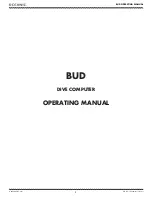Pyrocam IV Oper
ator’s Manual
Document No. 50337-001
Rev F
2/21/2017
Page 22
3.4.1.1
Internal Chopper
The internal chopper in the Pyrocam utilizes a closed-loop PID control system to keep
it running at a constant speed. When in
Pulsed
mode, the controller is still active,
maintaining the position of the chopper blade so that it doesn’t cover the detector.
Occasionally, the blade will jitter or make a little noise as the control loop makes slight
periodic adjustments to the chopper’s position.
The internal chopper is placed very close to the detector’s focal plane. Thus diffraction
effects are reduced and a sharper image is possible when an optional lens is fitted.
3.4.1.2
Beam Alignment
Chopped imaging is most accurate when the input laser beam is perpendicular to the
plane of the chopper/imager. Beams coming in at oblique angles will be chopped
somewhat out of phase. This can contribute to some loss in responsivity and/or
response linearity.
3.4.1.3
Damage Concerns
In Chopped mode, with the gain set to minimum (or near the minimum setting), the
output signal from the detector will saturate at about 5 W/cm². This is very near the
Pyrocam’s damage threshold of 8 W/cm².
WARNING
With a low GAIN setting, it is easy to inadvertently exceed the Pyrocam
detector’s damage threshold. For example: A one (1) Watt input beam,
with a TEM
00
Gaussian beam width of 5mm will have a peak power
density of 10 W/cm
2
. If left on the detector for a significant amount of
time, the detector will sustain damage in and around the region of peak
power density. Pyrocam detectors are very costly to replace, but if
treated with care they can last nearly as long as most other
semiconductor devices.
NOTE:
If the Pyrocam is placed into
Pulsed
operating mode, the
internal chopper will set itself to an open position. If you are
illuminating the detector with a CW laser and have placed the Pyrocam
into
Pulsed
mode, the total power falling on the detector will effectively
double, thus increasing the damage risk described above by a factor of
2.
3.5
Calibrate and Ultracal Cycles
Calibrate and Ultracal are two different operations but they are applied together when an
Ultracal
operation is initiated in BeamGage. Both operations must be performed without a
laser on the imager and under subdued room lighting if fitted with a window that transmits
room light or if no window is installed. Here’s how they differ:


















